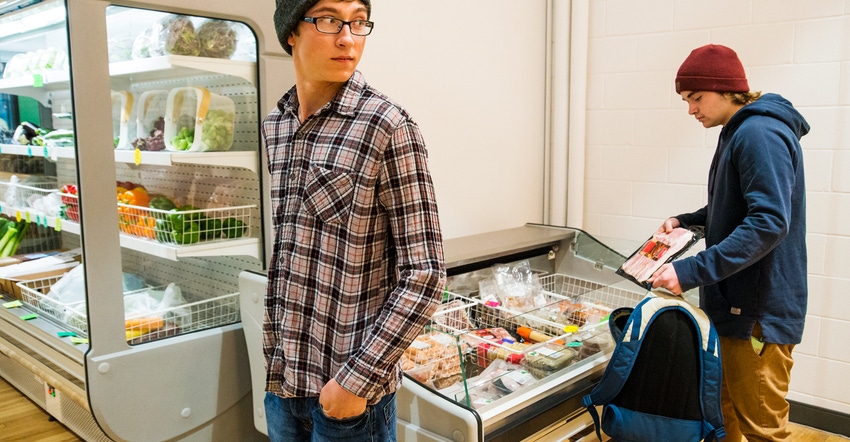July 24, 2019

More than $13 billion worth of goods is stolen from U.S. retailers every year, according to the National Association of Shoplifting Prevention, and grocery stores are prime targets. And because shoplifters come in all shapes, sizes, ages and socioeconomic classes, you never know which customers will attempt to steal. While some shoplifters do it professionally, stealing and reselling goods, most act on impulse and only pocket items if given the opportunity. Here are nine smart strategies to minimize theft in your store.
Retailer

loss prevention manager at Guido’s Fresh Marketplace,
Great Barrington and Pittsfield, Massachusetts
Prioritize customer service. Theft will always be part of doing business, but you can deter a lot of it by providing great customer service. It may sound obvious, but it really works. If someone is milling around in your department, go up to them and ask if they need help; have a conversation. If they are not a shoplifter, this just lets them know you’re attentive to their needs. Some customers don’t like to talk, and if they don’t, you’ll know it, but at least you’ve shown them you are there. If they are a shoplifter, they won’t want any attention on them, so now they probably won’t take anything then and there, or they’ll need a plan B. It’s a win-win situation for you.
Keep an eye on reusable shopping bags. Lately, we’ve been catching people filling shopping bags with groceries and trying to steal them. Last year, someone tried to take $1,500 worth of products. We probably encouraged this problem along the way because we want shoppers to bring reusable bags, but now we have our eyes on them. You can also try to discourage customers from shopping right into their bags. To do this, place additional baskets throughout the store, because many customers come in for a few things and then, 20 items later, realize they need one.
Get connected and network. I’m involved in organizations that deal with loss; there is one in western Massachusetts that meets every 60 days, and I bring back info to share with our staff. Whether or not you have a loss-prevention specialist on staff, it’s smart to join one of these organizations. They are great for networking too, so if any issues arise, you’ll know where to turn. If there isn’t a loss-prevention group near you, there is most likely a business association you can join.
Criminologist

doctorate in criminology, University of Leicester, Leicester, United Kingdom,
director of the Loss Prevention Research Council and co-leader of the University of Florida Crime Prevention Research Team
Know shoplifters’ targets and methods. Most items are taken for greed rather than need. These are usually high-dollar goods, such as health and beauty care, baby food, steak and shrimp. In criminology, we use the acronym CRAVED to understand why certain items are high-theft:
Concealable.
Removable.
Available.
Valuable.
Enjoyable.
Disposable—readily convertible to cash or drugs.
Most shoplifters will hide goods in a pocket, purse or shopping bag, but some just carry out items.
Watch for clusters of cues in context. Look for physical cues, such as large opaque shopping bags, and behavioral cues, such as how close someone is standing to a high-theft item, in clusters and in context. For example, a person with normal shopping behavior will stand at a certain distance and angle from a product, usually with their hands up and eyes down as they examine it. A shoplifter, on the other hand, may stand very close and at a stooped angle, with their hands down to conceal the item and eyes up to look for people or cameras. If you see this cluster of cues, it’s best to walk over and ask if they have any questions, but even just clearing your throat and looking in their direction can deter them.
Consider EVPMs. An alert and capable staff member is the best deterrent to shoplifting, but evidence shows that enhanced public view monitors—small screens put in high-theft departments or more desolate areas—are also very effective. Some EVPMs are small, about the size of an iPad, and can be mounted on flexible mounts. The lower you place an EVPM, the more likely a shoplifter will notice it.
Loss-prevention consultant

president of Loss Prevention Systems Inc.,
Kennesaw, Georgia
Implement EAS. You can never have enough floor staff to prevent shoplifting entirely. Plus, professional shoplifters may bring in three or four people to tie up resources and clear the aisles for another person to steal. This is why I strongly suggest electronic article surveillance systems, which put labels on items that trigger an alarm when taken out of the store. An EAS system will be there working for you 24/7. Expect a few of your “best” customers to get angry—because they’ve been stealing from you all along. They may be in every other day, but if you look at their purchases, they’ve been buying only minor items and stealing higher-dollar products.
Do a final check-in at checkout. At checkout, make eye contact with every customer and ask “Is there anything else?” Legitimate customers won’t have a problem with this, and they may even say, “Oh, I forgot X, Y or Z!” and be delighted you reminded them. However, a shoplifter, particularly an impulse shoplifter who has become nervous, will take that question completely differently. They might even pull the item out and say, “Oh yeah! I didn’t have room in the basket for this,” or give some other stupid excuse. What do you do then? Sell them the item! At least you’ve deterred them from shoplifting this time.
Call the cops. If you catch a shoplifter, read them the riot act and kick them out, they’ll let out a sigh of relief—but they might come back and try it again because you haven’t done enough to deter them. In my book, they have to be prosecuted, so you have to call the police. If you don’t, you’ll make yourself a target. The shoplifting community talks—even impulse shoplifters—sharing techniques and new opportunities online. If you don’t draw that line in the sand and prosecute, the issue will only get worse.
About the Author(s)
You May Also Like
.png?width=700&auto=webp&quality=80&disable=upscale)




